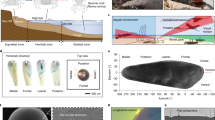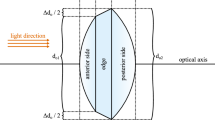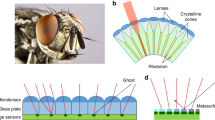Abstract
VISUAL ACUITY in falconiform birds has been shown to be higher than man. For instance, vultures with eyes similar in size to those of man have a grating detectability of about twice the spatial frequency of man1. This is consistent with measured image quality in an eagle eye similar in size to the human eye2. Recently a falcon (Falco sparverius) has been shown to have a grating detectability 2.6 greater than that of man3. Although the image quality of these falconiform eyes is at least twice as good as man, their minimum intercone spacing is only slightly less than in the human retina. Unless the ratio of focal length to the axial eye length of these birds greatly exceeds that in man, falconiform eyes, unlike man, would be unable to resolve their best retinal image quality. We show here that the presence of a spherical depression in the deep fovea of falconiforms may act like the negative lens component in a telephoto lens system or opera glass. The focal length of the birds' dioptrics can then in theory exceed the axial length of the eye, thus providing the relatively large images necessary for more complete image reconstruction (high resolving power) in a localised region of the retina.
This is a preview of subscription content, access via your institution
Access options
Subscribe to this journal
Receive 51 print issues and online access
$199.00 per year
only $3.90 per issue
Buy this article
- Purchase on Springer Link
- Instant access to full article PDF
Prices may be subject to local taxes which are calculated during checkout
Similar content being viewed by others
References
Fischer, A. B. Zool. Jb. Syst. Bd. 96, 81 (1969).
Shlaer, R. Science 176, 922 (1972).
Fox, R., Lehmkuhle, S. W. & Westendorf, D. H. Science 192, 263 (1976).
Miller, W. H. & Snyder, A. W. (in preparation).
Westheimer, G. in The Handbook of Sensory Physiology, Vol. VII/2 (ed. by Fuortes, M. G. F.)(Springer, New York, 1972).
Pumphrey, R. J. in Biology and Comparative Physiology of Birds (ed. Marshall, A. J.) (Academic, New York, 1961).
Hughes, A. in The Handbook of Sensory Physiology Vol. VII/5, Part A (ed. Crescetelli, F.) (Springer, New York, 1977).
Walls, G. L. The Vertebrate Eye (Cranbrook Institute of Science, Bloomfield Hills, Michigan, 1942).
Fite, K. V. Brain, Behav. Evol. 12, 97 (1975).
Pumphrey, R. J. J. exp. Biol. 25, 299 (1948).
Levi, L. Applied Optics (Wiley, New York, 1968).
Maurice, D. M. in The Eye Vol. 1 (ed. Davson, H.) 523 (Academic, New York, 1969).
Sidman, R. L. J. Biophys. Biochem. Cytol. 3, 15 (1957).
Wood, C. A. The Fundus Occuli of Birds plate XXXIII (Lakeside Press, Chicago, 1917).
Harkness, L. & Bennet-Clark, H. C. Nature 272, 814 (1978).
Snyder, A. W. J. opt. Soc. Am. 62, 1267 (1972).
Campbell, F. W. & Gubisch, R. W. J. Physiol., Lond. 186, 555 (1966).
Donner, K. O. Acta zool. fennica 66, 2 (1951).
Miller, W. H. & Snyder, A. W. Invest. Ophthal. Vis. Sci. Suppl. 105 (1977).
Author information
Authors and Affiliations
Rights and permissions
About this article
Cite this article
SNYDER, A., MILLER, W. Telephoto lens system of falconiform eyes. Nature 275, 127–129 (1978). https://doi.org/10.1038/275127a0
Received:
Accepted:
Published:
Issue Date:
DOI: https://doi.org/10.1038/275127a0
This article is cited by
-
Spatial acuity-sensitivity trade-off in the principal eyes of a jumping spider: possible adaptations to a ‘blended’ lifestyle
Journal of Comparative Physiology A (2021)
-
Foveal shape, ultrastructure and photoreceptor composition in yellow-legged gull, Larus michahellis (Naumann, 1840)
Zoomorphology (2021)
-
Inter-individual differences in foveal shape in a scavenging raptor, the black kite Milvus migrans
Scientific Reports (2020)
-
The potential role of Arhgef33 RhoGEF in foveal development in the zebra finch retina
Scientific Reports (2020)
-
The evolution of eyes: major steps. The Keeler lecture 2017: centenary of Keeler Ltd
Eye (2018)
Comments
By submitting a comment you agree to abide by our Terms and Community Guidelines. If you find something abusive or that does not comply with our terms or guidelines please flag it as inappropriate.



